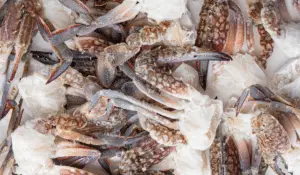Introduction to Freezing Crab
“Can you freeze crab?” This common question among seafood lovers has a positive answer. Freezing crab is a practical way to enjoy this delectable seafood throughout the year. The process isn’t complicated, but it requires attention to detail to preserve the crab’s natural flavor and quality. For comprehensive guidelines on freezing seafood, this article from the University of Minnesota Extension offers a thorough overview.
Understanding the Basics of Freezing Seafood
Freezing seafood, especially crab, involves more than just popping it into the freezer. It starts with proper preparation. The crab must be cleaned and prepped correctly, which might include cooking or shelling it before freezing. The freezing method – whether you’re dealing with whole crabs, crab meat, or crab-based dishes – significantly impacts the end result. You need to choose the right technique to maintain the crab’s taste and texture. Seafood Health Facts provides an excellent resource for detailed guidance on seafood preparation and freezing methods.
The Importance of Freshness in Freezing Crab
The freshness of the crab at the time of freezing is crucial. Fresh crab, when frozen, maintains its succulent flavor and moisture, giving you a near-fresh experience when it’s eventually thawed and cooked. The key is to freeze the crab as soon as possible after catching or purchasing it. This step locks in the freshness and ensures that the crab retains its quality, providing you with a delightful seafood feast anytime you desire.
In summary, freezing crab is not only possible, but it’s also a fantastic way to keep enjoying this seafood outside its peak season. With the right preparation and freezing techniques, you can have a supply of delicious crab ready to be enjoyed at any moment, preserving its ocean-fresh flavor for future culinary adventures.
For further reading and in-depth analysis, our extensive article on this topic is a valuable resource : Why is Crab So Expensive? An Insight into the Delicacy’s High Cost
Preparing Crab for Freezing
Selecting the Right Crabs for Freezing
Choosing the right crabs is critical when you’re planning to freeze them. Opt for fresh, live crabs as they offer superior flavor and texture once thawed. This is especially important for those wondering, “Can you freeze crab?” Yes, you can, but the initial quality of the crab is a significant factor in the end result.
Cleaning and Prepping Crabs Before Freezing
After selection, the next step is a thorough cleaning. Remove the shell and guts, ensuring the crab is safe and retains its quality when thawed and cooked. Proper cleaning not only maintains the quality but also simplifies later use in various recipes.
To Boil or Not to Boil: Pre-Freezing Preparation
Deciding whether to boil crabs before freezing is crucial. Boiling can ease the meat removal process and eliminate bacteria, extending the shelf life and safety of the frozen crab. However, some prefer to freeze the crab raw to maintain its fresh taste. If boiling, keep it brief to avoid flavor loss.
Methods of Freezing Crab: Understanding the Techniques
When it comes to freezing crab, you might ask, “Can you freeze crab effectively?” Yes, and there are several methods to do so, each with its own advantages and drawbacks.
Freezing Whole Crabs
Freezing whole crabs is straightforward. First, ensure they are clean and gutted. Then, simply place them in airtight freezer bags or containers. This method preserves the crab’s natural flavor and texture, but it does require more freezer space.
Freezing Crab Meat: A Step-by-Step Guide
For freezing crab meat, begin by cooking and shelling the crab. Next, portion the meat into usable amounts, and place it in airtight containers or vacuum-seal bags. This method is space-efficient and convenient for later use, though it takes more initial preparation.
Tips for Freezing Crab Cakes and Bisques
Crab cakes and bisques freeze well, too. For crab cakes, first cook them as usual, then cool, wrap individually, and freeze. This preserves their texture and makes them easy to reheat. For bisques, cool the soup completely before transferring it to airtight containers. Leave some space at the top as the bisque will expand when frozen. These methods are perfect for enjoying these dishes later, retaining the fresh taste of crab.
Packaging and Storage: Best Practices for Freezing Crab
When it comes to freezing crab, proper packaging is crucial for maintaining quality. Many wonder, “Can you freeze crab without losing its freshness?” The answer lies in how you package and store it.
Best Practices for Packaging Crab for Freezing
The first step is choosing the right container. For whole crabs, use sturdy, airtight freezer bags or containers. If you’re freezing crab meat, consider vacuum-sealing to remove all air, as this helps prevent freezer burn and extends shelf life. Wrap crab cakes and bisques tightly in cling film before placing them in containers.
The Role of Air-Tight Sealing in Preserving Quality
Air-tight sealing is essential in preserving the crab’s quality. It prevents the entry of air and moisture, which can cause spoilage and freezer burn. This sealing keeps the crab tasting fresh and retains its texture.
Ideal Freezing Temperatures for Crab
Finally, set your freezer to the right temperature. The ideal temperature for freezing crab is at or below 0°F (-18°C). This temperature halts bacterial growth and preserves the crab’s integrity for longer periods. Remember, consistent temperature is key, so avoid frequently opening and closing your freezer, as this can cause temperature fluctuations.
By following these best practices in packaging and storage, you can enjoy high-quality, frozen crab whenever you crave it.
Thawing and Cooking Frozen Crab
Many people ask, “Can you freeze crab and still enjoy its original flavor and texture?” Absolutely, and the key lies in proper thawing and cooking.
Safe Thawing Techniques for Frozen Crab
To safely thaw frozen crab, transfer it from the freezer to the refrigerator. This slow thawing process, which takes several hours or overnight, ensures the crab remains at a safe temperature, reducing the risk of bacterial growth. Avoid thawing crab at room temperature, as this can compromise its safety and quality.
Maintaining Flavor and Texture: Cooking Thawed Crab
Once thawed, cooking the crab correctly is crucial to maintaining its flavor and texture. For whole crabs or crab legs, steaming is an excellent method. It’s gentle and helps retain the crab’s natural juiciness and delicate flavor. If you’re reheating crab meat, do so gently over low heat, and consider adding a splash of water or broth to keep it moist.
If you’re interested in exploring Flavors, I highly recommend exploring Ultimate Crab Cake Sandwich Recipe: A Coastal Delight
Creative Recipes for Thawed Crab
Thawed crab offers versatility in the kitchen. Use it in classic dishes like crab cakes or crab bisques, or try something new like a crab and avocado salad, or a crab pasta with garlic and lemon. The sweet, delicate flavor of crab pairs well with a variety of ingredients, offering endless culinary possibilities. Whether you’re making a simple crab sandwich or an elaborate crab-stuffed ravioli, the key is to let the natural flavor of the crab shine.
Discover more culinary delights by checking out Ultimate Crab Cake Sandwich Recipe: A Coastal Delight
Discover more culinary delights by checking out Ultimate Mexican Chicken Salad Recipe: Fresh, Flavorful & Easy!, a perfect complement to today’s dish
Health and Safety Considerations When Freezing Crab
Properly freezing crab is not only about preserving its flavor and texture but also about ensuring its safety for consumption. Understanding the risks associated with improper freezing and knowing the shelf life of frozen crab are crucial for your health.
Understanding the Risks of Improper Freezing
Improper freezing techniques can lead to several risks. The foremost concern is the growth of harmful bacteria, which can cause foodborne illnesses. If crab is not frozen quickly and at the right temperature, bacteria can proliferate. This is especially true for seafood, which is often more susceptible to bacterial contamination than other types of food. Additionally, improper freezing can lead to freezer burn, which, while not a health risk, significantly deteriorates the quality and taste of the crab. For more details on safe food handling, especially for seafood, visit FoodSafety.gov – Safe Minimum Cooking Temperatures.
Best-by Dates: How Long Can You Keep Crab Frozen?
The shelf life of frozen crab depends on the freezing method and the type of crab. Generally, properly frozen and stored crab can last for up to three months without significant loss of quality. However, it’s safe to consume for longer periods, provided it has been kept at a consistent temperature of 0°F (-18°C) or lower. To ensure the best quality, label the crab with the freezing date before storing it. This practice helps in tracking how long the crab has been frozen and prevents the risk of consuming spoiled seafood. For a comprehensive guide on the storage of frozen foods, including seafood, refer to the FDA’s Refrigerator and Freezer Storage Chart.
In conclusion, understanding the health and safety aspects of freezing crab is essential. By ensuring proper freezing techniques and being aware of the best-by dates, you can enjoy delicious and safe crab dishes.
To gain a comprehensive insight into this subject, be sure to check out our detailed guide here:
Are Crab Cakes Healthy? Unraveling the Nutritional Facts
Freezing Crab vs. Other Seafoods: A Comparative Analysis
Conclusion: Enjoying Frozen Crab All Year Round
Freezing crab is an excellent way to extend the enjoyment of this delectable seafood throughout the year. By understanding the best practices for freezing, from selecting the right crabs to packaging them correctly, you can ensure that the crab retains its freshness, flavor, and texture. Whether you prefer whole crabs, crab meat, or even crab-based dishes like cakes and bisques, the freezing methods discussed provide a roadmap for preserving their quality.
The health and safety considerations, along with the FAQs, offer additional guidance to handle crab in a way that maximizes both safety and taste. Remember, while freezing can slightly alter the crab’s taste, proper techniques can minimize these changes, allowing you to enjoy nearly fresh-tasting crab even out of season.
In essence, freezing crab opens up a world of culinary possibilities, ensuring that you can savor this seafood delicacy anytime, regardless of the season. So, the next time you have an abundance of fresh crab, don’t hesitate to freeze it and relish the flavors all year round.




6 thoughts on “Can You Freeze Crab? Essential Tips for Freshness and Safety”
Comments are closed.